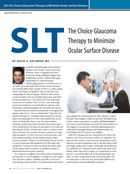Articles / News
Smoking has been directly linked to two of the leading causes of vision loss, cataracts and macular degeneration. In fact, researchers believe smoking also causes or contributes to a number of other eye health problems. Smoking and cataracts Studies have shown that smokers have double the risk of developing cataracts compared with non-smokers. This risk triples for heavy smokers. In fact, doctors have discovered a specific relationship between cataracts and the amount that you smoke — the more you smoke, the higher your chances of developing cataracts. Cataracts occur when the eye’s naturally clear lens grows cloudy over time. This … Read more…
Atropine is a drop used to dilate the eye. It is derived from the plant Atropa belladonna. Belladonna leaves were used by 17th century Italian women to dilate their eyes because they thought it made them appear more beautiful. That’s why the plant is called bella (fair) donna (lady), or a beautiful woman.
Healthy eyes and vision are a critical part of childhood development. Your child’s eyes should be examined regularly, as many vision problems and eye diseases can be detected and treated early. Vision problems can affect not only an infant’s ability to develop good hand-eye coordination, but also depth perception and other basic skills. Having poor vision can cause your child to do poorly at school or in sports, prompting anger and frustration. Having regular eye exams are important for your child’s overall health and wellbeing. Unfortunately, studies have shown that only one in three children ages 6 to 16 has … Read more…
A corneal abrasion is a scratch on the eye’s cornea. The cornea is the clear, protective covering over the iris (the colored part of the eye) and the pupil (the black circle in the middle of the eye). It’s important both for vision and for protecting the eye. If you poke your eye or if something gets trapped under your eyelid — such as dirt or sand — your cornea may become scratched. When it does, it can cause significant pain and discomfort. What causes a corneal abrasion? • Being poked in the eye • Dirt, dust, sand or some … Read more…
Eyes heal quickly. With proper care, it only takes about 48 hours for the eye to repair a corneal scratch.
20/20 vision is a term used to express normal visual acuity measured at a distance of 20 feet. If you have 20/20 vision, you can see clearly at 20 feet what should normally be seen at a distance. If you have 20/200 vision, it means that you must be as close as 20 feet to see what a person with normal vision can see at 200 feet. 20/20 does not necessarily mean perfect vision. 20/20 vision only indicates the sharpness or clarity of vision at a distance. Some people are able to see well at distance, but are unable to … Read more…
Peninsula Laser Eye Medical Group Introduces Revolutionary Technology To Help Improve Visual Results For Cataract Surgery Patients Peninsula Laser Eye Medical Group is now offering the ORA System, a new intraoperative device that provides real-time measurements of the eye during cataract surgery. Using this system, Dr. Dan Beers and Dr. Jeffrey Liu can evaluate the optical conditions in your eye after the cataract (or natural lens) has been removed. The ORA System guides the surgeon to determine the most accurate intraocular lens (IOL) power to correct refractive error and astigmatism, resulting in the clearest possible vision after cataract surgery. The … Read more…
Peninsula Laser Eye Medical Group First in Mountain View to Offer the ORA System® with VerifEye™ for LASIK-Like Cataract Surgery Results ORA-Guided Cataract Surgery is a Major Advancement Now Available to Local Patients Mountain View, CA – (2013) – Peninsula Laser Eye Medical Group in Mountain View, CA is proud to offer a breakthrough cataract procedure technology that enables surgeons to provide LASIK-like visual quality to area patients. The ORA System® with VerifEye™ is a revolutionary new way to analyze the eye during premium cataract surgery, enabling our doctors to tailor treatment specifically to each patient’s eye. “We’re extremely … Read more…

Scientific breakthroughs have allowed people to live longer, more active lives. Whereas vision is arguably the most important thing ophthalmologists can rehabilitate, ocular comfort often goes overlooked or underestimated.
Lovely Edyta Sliwinska, a popular alumnus of “Dancing With the Stars,” is sporting more than a few new dance moves these days. The professional dancer, who considered herself legally blind without her contact lenses, debuted a new set of eyes, thanks to Visian ICL. “If I do not wear my contact lenses,” Sliwinska notes, “I do not dance…I see perfectly now!” The surgery was performed by Dr. Paul Dougherty at the Dougherty Vision Clinic in Los Angeles. Sliwinska is still such a favorite with fans even after leaving the show that KTLA television in Los Angeles covered her procedure.